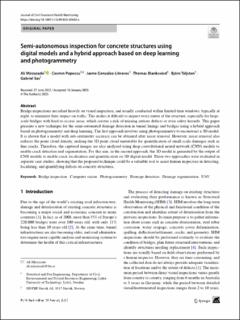| dc.contributor.author | Mirzazade, Ali | |
| dc.contributor.author | Popescu, Cosmin | |
| dc.contributor.author | Gonzalez-Libreros, Jaime | |
| dc.contributor.author | Blanksvärd, Thomas | |
| dc.contributor.author | Täljsten, Björn | |
| dc.contributor.author | Sas, Gabriel | |
| dc.date.accessioned | 2023-04-20T13:02:16Z | |
| dc.date.available | 2023-04-20T13:02:16Z | |
| dc.date.created | 2023-04-04T11:10:06Z | |
| dc.date.issued | 2023 | |
| dc.identifier.citation | Journal of Civil Structural Health Monitoring (JCSHM). 2023, . | |
| dc.identifier.issn | 2190-5452 | |
| dc.identifier.uri | https://hdl.handle.net/11250/3064074 | |
| dc.description.abstract | Bridge inspections are relied heavily on visual inspection, and usually conducted within limited time windows, typically at night, to minimize their impact on traffic. This makes it difficult to inspect every meter of the structure, especially for largescale bridges with hard-to-access areas, which creates a risk of missing serious defects or even safety hazards. This paper presents a new technique for the semi-automated damage detection in tunnel linings and bridges using a hybrid approach based on photogrammetry and deep learning. The first approach involves using photogrammetry to reconstruct a 3D model. It is shown that a model with sub-centimeter accuracy can be obtained after noise removal. However, noise removal also reduces the point cloud density, making the 3D point cloud unsuitable for quantification of small-scale damages such as fine cracks. Therefore, the captured images are also analysed using deep convolutional neural network (CNN) models to enable crack detection and segmentation. For this aim, in the second approach, the 3D model is generated by the output of CNN models to enable crack localization and quantification on 3D digital model. These two approaches were evaluated in separate case studies, showing that the proposed technique could be a valuable tool to assist human inspectors in detecting, localizing, and quantifying defects on concrete structures. | |
| dc.description.abstract | Semi‑autonomous inspection for concrete structures using digital models and a hybrid approach based on deep learning and photogrammetry | |
| dc.language.iso | eng | |
| dc.subject | Photogrammetry | |
| dc.subject | Photogrammetry | |
| dc.subject | Computer vision | |
| dc.subject | Computer vision | |
| dc.subject | Damage detection | |
| dc.subject | Damage detection | |
| dc.subject | Bridge inspection | |
| dc.subject | Bridge inspection | |
| dc.title | Semi‑autonomous inspection for concrete structures using digital models and a hybrid approach based on deep learning and photogrammetry | |
| dc.title.alternative | Semi‑autonomous inspection for concrete structures using digital models and a hybrid approach based on deep learning and photogrammetry | |
| dc.type | Peer reviewed | |
| dc.type | Journal article | |
| dc.description.version | publishedVersion | |
| dc.subject.nsi | VDP::Teknologi: 500 | |
| dc.subject.nsi | VDP::Technology: 500 | |
| dc.source.pagenumber | 20 | |
| dc.source.journal | Journal of Civil Structural Health Monitoring (JCSHM) | |
| dc.identifier.doi | 10.1007/s13349-023-00680-x | |
| dc.identifier.cristin | 2139348 | |
| dc.relation.project | Andre: EU Horizon, Shift2Rail. No.101012456. IN2TRACK3 | |
| dc.relation.project | Andre: LTU - funding open access | |
| dc.relation.project | Andre: FORMAS, no. 2019-01515 | |
| cristin.ispublished | true | |
| cristin.fulltext | original | |
| cristin.qualitycode | 1 | |
